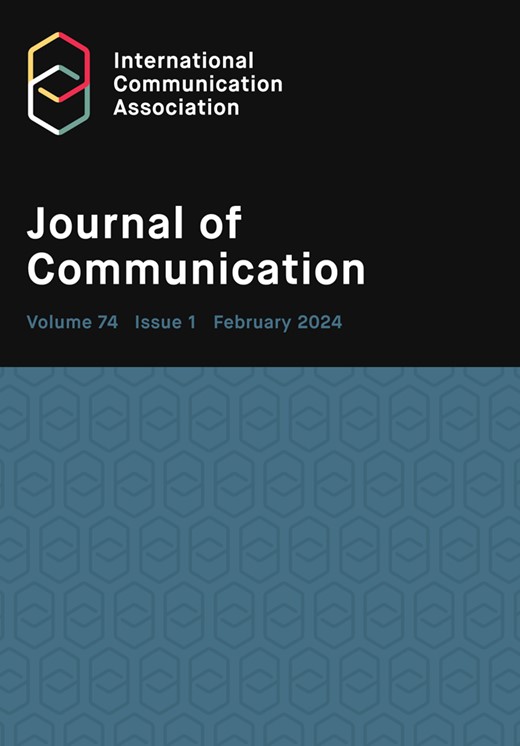Testing relational turbulence theory in daily life using dynamic structural equation modeling
IF 6.1
1区 文学
Q1 COMMUNICATION
引用次数: 0
Abstract
Using dynamic structural equation modeling (DSEM; Asparouhov et al., 2018), this study tests how partner disruptions of daily routines create a chaotic relational state through intensified emotions directed at partners, as posited by relational turbulence theory (RTT; Solomon et al., 2016). To test this affective process, individuals in dating relationships (N = 130) completed daily surveys for 30 days (T = 30; 3,478 total observations), measuring that day’s interference from their partner, anger experienced while interacting with their partner, and their relational turbulence. DSEM accounted for the intensive longitudinal aspects of the data while modeling three types of person-specific random effects: random intercepts to account for subject-specific averages; random slopes to account for subject-specific effects; and random variances to account for subject-specific volatility. RTT processes were supported, as greater than typical interference of routines in daily life predicted more relational turbulence that day via increased daily anger (controlling for the previous day’s levels). The use of DSEM allowed us to further test RTT by modeling person-specific inertia and volatility (for levels of interference, anger, and relational turbulence throughout a month). The use of a multilevel “location-scale” DSEM with random intercepts and random variances revealed that attachment avoidance and anxiety predicted a variety of person-specific features of the studied longitudinal processes: averages, inertia, and volatility over time. We provide our data and a supplemental primer to illustrate how to test communication theory with DSEM and model the intensive dynamics of daily life.利用动态结构方程模型检验日常生活中的关系湍流理论
本研究使用动态结构方程建模(DSEM;Asparouhov 等人,2018 年),检验了伴侣对日常生活的干扰是如何通过强化针对伴侣的情绪来创造混乱的关系状态的,正如关系动荡理论(RTT;Solomon 等人,2016 年)所假设的那样。为了检验这一情感过程,约会关系中的个体(N = 130)完成了为期 30 天(T = 30;总观察次数为 3,478 次)的每日调查,测量当天来自伴侣的干扰、与伴侣互动时的愤怒体验以及他们的关系动荡。DSEM 考虑了数据的密集纵向方面,同时模拟了三种特定个人的随机效应:随机截距以考虑特定对象的平均值;随机斜率以考虑特定对象的效应;随机方差以考虑特定对象的波动性。RTT过程得到了支持,因为日常生活中例行公事的干扰比一般情况下更大,这预示着当天的关系动荡会通过增加日常愤怒而加剧(控制前一天的水平)。DSEM 的使用使我们能够通过模拟特定人的惯性和波动(一个月内的干扰、愤怒和关系动荡水平)来进一步检验 RTT。通过使用具有随机截距和随机方差的多层次 "位置尺度 "DSEM,我们发现依恋回避和焦虑可以预测所研究的纵向过程的各种特定个人特征:随时间变化的平均值、惯性和波动性。我们提供了我们的数据和补充入门资料,以说明如何用 DSEM 检验传播理论,并对日常生活中的密集动态进行建模。
本文章由计算机程序翻译,如有差异,请以英文原文为准。
求助全文
约1分钟内获得全文
求助全文
来源期刊

Journal of Communication
COMMUNICATION-
CiteScore
11.60
自引率
5.10%
发文量
41
期刊介绍:
The Journal of Communication, the flagship journal of the International Communication Association, is a vital publication for communication specialists and policymakers alike. Focusing on communication research, practice, policy, and theory, it delivers the latest and most significant findings in communication studies. The journal also includes an extensive book review section and symposia of selected studies on current issues. JoC publishes top-quality scholarship on all aspects of communication, with a particular interest in research that transcends disciplinary and sub-field boundaries.
 求助内容:
求助内容: 应助结果提醒方式:
应助结果提醒方式:


